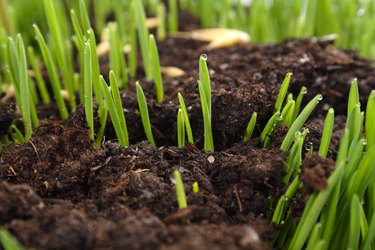
If you're overseeding an existing lawn, you generally don't have to worry about covering the new grass seeds because they get ample protection from the grass blades. If you're planting a brand-new lawn, however, the seeds need some protection from the sun and the rain, or they could wash away or dry out before they have a chance to germinate. The layer shouldn't be very thick because the seeds do need some sun exposure, so a thin layer of soil is usually enough except on hillsides, where you need straw or something similar that won't wash away.
Preparing the Soil Facilitates Planting
Video of the Day
Imagine if you were a grass seed and someone threw you on a compacted, dried-out patch of ground. You'd feel exposed and unprotected, as you would be, and if you somehow managed to get enough moisture and stay in one place long enough to sprout roots, you'd have a hard time pushing the roots into the hard ground. In the midst of all this adversity, you'd probably just give up.
Video of the Day
The savvy gardener, in an effort to avoid exposing new seeds to all this hardship, prepares the soil by loosening it with a rake or if it's really compacted, with a core aerator. You might also consider spreading a layer of topsoil or compost, which will all but guarantee a fertile growing environment for the new grass.
Covering Grass Seed After Planting
If you took the time to prepare the soil before planting, covering the seed is easy. Simply rake the soil lightly to cover the seeds with no more than about 1/4 inch of topsoil. If you didn't prepare the soil, you can protect the seeds with a thin layer of straw or sawdust mulch. These are also good mulch materials for hillsides.
When spreading straw, take the time to separate it by hand to be sure you don't spread too much. You don't want to lay straw in clumps, and the mulch layer should be thin enough for the seeds to be visible underneath. In lieu of straw, you can also use paper mulch or even burlap, which is an especially stable ground cover for hillsides. Burlap is a biodegradable material that will decompose and become part of the soil when the lawn matures.
Don't Introduce Weeds
If you decide to use straw mulch, make sure it's sterile. Hay used for cattle feed is a poor choice for grass mulch because it contains a lot of seeds that will emerge with the grass as weeds. Any oat, barley or wheat straw that you purchase from a garden center that is marketed specifically for mulching should be sterile and seed-free.
Besides straw and burlap, you can also cover germinating grass seed with a number of other types of mulch. Mushroom compost is a good choice because it's full of nutrients, and you can also use peat moss. Just be sure to spread a thin layer no more than 1/4 inch thick.